UK Car Guide ›› British Classic Car Makers You May Not Know
Lesser Known British Car Makers
Some have gone, and many are either forgotten or never heard of! Yet, some of the best British classic cars built in the last 100 years are still around today.
Take a trip down memory lane and reminisce through this list of car manufacturers from yesteryear that only true aficionados will have heard of... maybe!
Do You Know these Great British Classics?
To begin, here's a few easy ones to get you in the right era! We think you're already familiar with:
- Austin Westminster
- Hillman Imp
- Sunbeam Talbot
- Triumph Toledo
If you are knowledgeable about historic and vintage cars, you will already know most have become discontinued marques.
So, we decided to construct an alphabetical list of the less well-remembered creations from the best of British car manufacturers with a base in the United Kingdom.
Editor's Bio: We are self-confessed car fanatics and we enjoy writing blog articles about the automotive industry - especially here in the West Midlands.
Alldays & Onions
The actual merger of Onions (a family of craftsmen) and William Allday & Co. engineering companies took place in 1889.
Unification of these time-honoured manufacturers resulted in the formation of Alldays & Onions Pneumatic Engineering Co. of Birmingham.
And the outcome...
They had already established a good name for making "Alldays Cycles" and quadricycles. But, they started manufacturing cars in 1898 at their base at Great Western Works and Matchless Works in the inner-city of Small Heath.
The first car produced by Alldays & Onions was a quadricycle with a steering wheel, called Alldays Traveller Voiturette. It was one of the first British classic cars that featured gas lights, wooden-spoke wheels, and an unsprung rear end.
In 1903, the product range of the company expanded and they started making motorcycles, tractors, and motor lorries (vans).
Historic records suggest they started producing around ten (10) cars a week from 1911, including some for export. Most of the company's commercial success came from the 1.6-litre, vertical-twin side-valve 10/12, made between 1905 and 1913.
Note: Alldays & Onions also manufactured large commercial vehicles, up to five tons, in the years leading up to the first World War. In fact, many of these trucks actually saw service during the global conflict.
Arrol-Johnston
A Glaswegian locomotive engineer and inventor, named George Johnston, developed Scotland's first motor car in 1895. Soon after, he created "Mo-Car Syndicate Limited, Glasgow," to help turn it into a commercial operation.
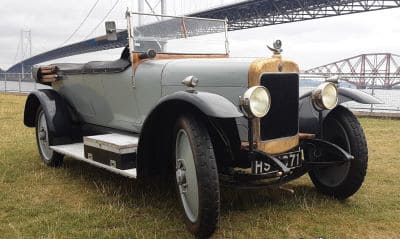 It started with a two-wheeled horse-drawn vehicle called the "dogcart".
It started with a two-wheeled horse-drawn vehicle called the "dogcart".
But, Arrol-Johnston later developed a reputation for building much grander vehicles, including the 1919 15.9hp Tourer.
Here's the deal:
The formation of a company with William Arrol, who was the architect of the Forth Bridge, brought about the petrol-engined Arrol Johnston car.
Even though they needed support from William Beardmore and Company engineers, the partnership based in Paisley became a pioneer of the motorcar industry within a few years.
They also developed the first "off-roading" vehicle in the world, contracted for the Egyptian government.
Arrol Johnston acquired land at Heathhall in 1913 and commissioned an American firm to build a factory near Dumfries. Historians suggest it was a copy of the factory in Michigan where they first produced the Model T Ford.
Another famous design was the one used for travelling on snow and ice to the South Pole, the treacherous expedition undertaken by Ernest Shackleton from 1914.
Ascari
This British car maker adopted its name from the Italian racing driver "Alberto Ascari". But, it was founded by "Klaas Zwart" of Petroline and based in Banbury, northern Oxfordshire in England.
Ascari launched their first limited-edition mid-engine sports car in 1998, called the Ascari Ecosse, based on the Ascari FGT prototype.
After suffering significant financial losses, mainly due to declining sales, the British sports car manufacturer filed for bankruptcy in 2010.
Atalanta
Some of the cool cars you never heard of could include several British car companies that used the name Atalanta.
In fact, at one time Armstrong Siddeley used the moniker for the Armstrong Whitworth Atalanta aircraft.
However, there was an Atalanta building sports cars between 1937 and 1939 from their factory in Staines, Middlesex. Most of the twenty or so vehicles they produced had four-cylinder engines. Others were using the Lincoln-Zephyr V12 to generate power.
Pro Tip: We travelled back a few decades to create a list of the best classic cars for dog owners, and why certain breeds are better suited to a certain vintage.
Bean Cars
The historic brand of motor vehicles known as Bean Cars came from factories in Dudley, Staffordshire, and Worcestershire.
They first started manufacturing cars in 1919, outselling Austin and Morris Motors for a few years. But, the company diversified into light commercials from 1924.
Moving on...
It is fair to say their first vintage was one of the obscure British cars in history. The constructors linked the 1795 cc four-cylinder engine to a separate three-speed gearbox.
Not only did the Bean car start the revival of the pre-war Perry 11.9, it had a cheap chassis costing around £245. As popularity grew for the four-seater open bodied vehicle, production peaked around 80 per week in 1922.
Under new ownership, the factory in Coseley moved on to other creations, including the construction of the world-land-speed-record car called "Thunderbolt" in the 1930s. Two supercharged 37-litre Rolls-Royce aero engines helped it attain a top speed record of 357.50 mph (575.34 km/h).
Beardmore Motors
The British engineers trading as William Beardmore and Company began manufacturing cars and London-type taxis after the First World War around 1919.
Their first car was a 1486cc, four-cylinder 11.4 with a 4-cylinder overhead camshaft (OHC) engine, which they manufactured at the district of Anniesland, in Glasgow.
But wait - there's more:
In 1929, the directors removed William from the board of the company during the purchase of Beardmore Motors. They also moved the taxi production from Scotland to northwest London (Hendon in the Borough of Barnet).
The introduction of the Mk4 Paramount (an updated Mk3 with a 2-litre Commer engine and box) took place in 1932.
Three years later, the longer wheel-base chassis version called the Mk5 Paramount Ace also made its debut - nicknamed "the greengrocer's barrow".
Belsize Motors
In fact, this may qualify with the best British cars that history forgot about. Marshall & Company founded Belsize Motors in 1901 in Clayton, a suburb of Manchester, England.
Belsize already had more than a decade of car production before the Ford Motor Company started building cars at Trafford Park in 1911.
Despite being less successful than the American motor manufacturer, Belsize produced around 3,000 cars during the peak of 1913, until the company finally folded in 1925.
Bristol Cars
Produced by Bristol Cars in 2004, the Bristol Fighter is a 2-door supercar with a turbocharged 8.0-liter V-10 (ten cylinder piston) based on the Dodge Ram SRT-10 pick up and the Dodge Viper.
The company, based in the town of Filton, South Gloucestershire, finally suspended manufacturing back in 2011.
Clan
Have you ever heard of this blast from the past? The 1971 Clan Crusader is an ultra-lightweight fibreglass monocoque (single shell) British sports car.
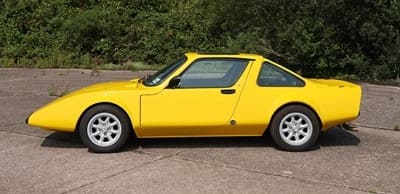 The manufacturers of the Clan operated from the small town of Washington in County Durham, Tyne and Wear, England.
The manufacturers of the Clan operated from the small town of Washington in County Durham, Tyne and Wear, England.
They built it using the running gear from the Hillman Imp Sport and a modified "Coventry Climax" for the rear-mounted 875 cc engine.
The designers, including former engineers from Lotus Cars, received a government grant for the production.
Nevertheless, the only car produced by the original "Clan" company was the Crusader (1971-74), including three competition versions. They were all ultra lightweight and achieved some success in circuit racing and car rallies.
The Clover and the McCoy
The founding company ceased trading in November 1973 after producing more than 300 Clan sports cars from the first phase. However, several restyled versions underwent production in England and in Northern Ireland.
One of them, the Clover, used the Boxer engine and gearbox from an early Alfa Romeo. Another, called the McCoy, was a reworked front-wheel drive version with a Mini engine and improved glazing.
Clyno
In the early 1900s, Clyno started manufacturing motorcycles and cars from their base in the small market town of Thrapston, North Northamptonshire.
After transferring the operation to a large factory in Wolverhampton in 1910, the company produced more than 15,000 motorcycles and about 40,000 cars. As a result, they were the third biggest car manufacturer in Britain.
Clyno suffered financial problems even after they started producing the Clyno 12 hp car in 1927. A legacy came to an abrupt end two years later the official receiver was appointed to wind up the under capitalised company.
Crossley Motors
Very few classic car makers also produced buses and military vehicles during the first half of the twentieth century. But that's exactly what Crossley did from their base in Manchester.
Their true classics, including the Crossley 12/14 hp introduced in 1909, were popular with the upper end of the market. For this reason, it took them about thirty years to build and sell 19,000 of these vehicles.
Despite becoming a division of Associated Commercial Vehicles (ACV), Crossley closed voluntarily in 1958 and was sold the following year. In 1969, British Leyland restarted production of their single-decker buses under the new name of Leyland International.
Pro Tip: We created a list of cars named after a place (e.g. the Bentley Brooklands) with a brief anecdote about the relationship between the locality and the car named after it.
Davrian
Davrian Developments built a series of monocoque glass fibre sports cars ranging from the 2-seat Mark 1 in 1965 to the Mark 8 Davrian Dragon in 1980.
The company started out in Clapham, London until they moved the operation to Tregaron, Wales, in 1976 and then again in 1980 to Lampeter, Ceredigion, until 1983.
Here's the thing:
They based most of the car's structural components on the Hillman Imp (e.g. the 875 or 998 cc engine and the front and rear suspension).
After the company went into administration in 1983, the Corry Car Company had the rights to the Davrian Dragon and they transferred the production to the city of Lisburn in Northern Ireland.
Further restyling of the model resulted in the Corry Cultra using engines and suspension based on the Ford Mark III Cortina.
From 1986, another revival took place and the modifications resulted in the mid-engined Darrian - using a combination of components from one of the old Ford models or the Rover V8.
Deep Sanderson
This list of fascinating British cars made over the years has to include the small sports coupés and single-seater racing cars falling under the Deep Sanderson brand.
But, the altered design of the DS301s meant they could produce these mid-engined cars for road use. It had a central tube chassis and a Mini drivetrain (engine and gearbox).
Note: The designer, Chris Lawrence, often drove his own creations in competitions. He was also a tuner of the Standard engine used in the Triumph TR sports cars and his own Morgan race car.
Dellow
The factory where Delsons produced nuts and bolts in Alvechurch, Bromsgrove, south of Birmingham, was also the building where Dellow made their road-going sports cars from 1949 to 1956.
They used Ford E93A engines to power most of the six (6) different models. But, there was also an option to choose the Wade-Ventor (Roots type) supercharger installation.
After building close to 300 examples, some of the appeal for owning Dellow sports cars had worn off and they ended the production in 1957 with the Mark VI.
Galloway
Another car builder trying to make a mark in Scotland was actually a subsidiary company to Arrol-Johnston called Galloway, first founded in 1920.
They set up the manufacturing operation at the village of Tongland, Kirkcudbrightshire, until they moved it to Heathhall, Dumfries in 1923.
Most of the employees involved in the production of the Galloway 10/20 were women, and they focused on selling it to female drivers. But, history suggests they got the timing wrong and the factory closed in 1928 after being formally wound up.
Gibbs
The Gibbs Aquada probably should have been more mainstream, but the High Speed Amphibian (HSA) was anything but.
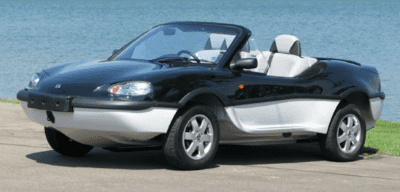 In all fairness, it's capable of speeds in excess of 100 miles per hour on good old terra firma.
In all fairness, it's capable of speeds in excess of 100 miles per hour on good old terra firma.
Plus, the manufacturers say it can attain a speed of 30mph (48 km/h) as it skips over water.
In case you were wondering:
These amphibious cars use the 4-speed automatic transmission for land and they use a jet-ski kind of propulsion system in water.
In true Mclaren F1 style, the driver's seat is positioned in the middle of the vehicle and there are two extra seats for passengers on either side.
This lesser known British car maker produced a vehicle that has no roof and there are no doors. If this is a car that appeals to your adventurous nature the Gibbs Aquada will set you back about £200,000.
Gilbern
How many of these British car makers from days gone by have you heard of so far? The Gilbern Invader is one of the rarest car models that ever came out of Wales. The interior wasn't short on luxury either, with power windows and walnut trim.
Despite the fibreglass body, it actually featured a Ford Essex 3.0-liter V-6 fuel injected engine. They also started using MGC for the suspension when production first started in Llantwit Fardre from 1969 through to 1973.
Ginetta
You will be forgiven if you forgot this one still exists, but the Ginetta Akula is actually a road legal British supercar. The makers first unveiled it at the Geneva International Motor Show in March 2019.
It weighs 1,150 kilograms (2,535 pounds) - which is about the same as a Ford Fiesta - and it has a top speed of 200 mph (321 km/h) with 600 brake horsepower (bhp).
They say if you need to ask the price you probably can't afford it! Well, if you want to buy a Ginetta Akula it is going to cost you something in the region of £421,000.
James and Browne
Based in the Hammersmith district of west London, James & Browne was a famous manufacturer of British automobiles from 1898 to 1910.
The original partnership existed between the former racing cyclist John Melville James and Tom Bousquet Browne. They had a factory in Chiswick and a car showroom in Oxford street.
Imagine...
The engine layout of the early examples had the flywheel situated between horizontal cylinders. They had the engine mid-mounted in the chassis with a 4-speed gearbox and chain.
A connecting rod linked the two separate parts of the gearbox. The left side contained 2nd and 4th gears, while 3rd and reverse was on the right.
Popular Blog Posts
So far, we have covered 19 of the best British classic car makers you might not know... and we're only half way through!
This might be a good time to bookmark this page for later, and take a look through some of the most read articles from our car blog.
- A to Z list of cars unsold in the United Kingdom... and why not?
- Cars named after places, cities, and states in the US.
- How old is a classic car as an age requirement in the United Kingdom?
- How to import a new car into the UK using the V55/5 application?
- Which are the Best Classic Cars for Dogs and their Owners?
Pro Tip: The main blogger section contains a full list of automotive blog topics and trending articles about different makes and models... from bangers to Bentleys!
Marauder Car Company
Two ex-Rover engineers started a new car venture in 1951. They developed a two-seater sports car with a chassis, and some body panels, based on the new Rover P4 series.
After registering the new business name to Marauder Car Company, they made about fifteen (15) cars at the workshop in Solihull, West Midlands to begin with, and then later at Kenilworth in Warwickshire.
Here's the kicker:
They may have been producing some of the greatest British-built two-seater sports cars and coupés at the time. But, the Chancellor imposed an abrupt increase to the existing level of Purchase tax on cars.
In essence, this tax increase almost doubled the cost of the Marauder 100 series from £1,236 to more than £2,000 in 1952. The two engineers failed to survive the effect of this extra taxation and they both rejoined Rover.
Marendaz
They called them the Marendaz Special cars, and they made them in London from 1926. The construction moved to Maidenhead in Berkshire where the "jam factory" continued through to 1936.
One of the first offerings was the Marendaz Special 11/55 sports car with a 1496 cc side-valve 4-cylinder Anzani engine.
The later models, powered by smaller 1094 cc and larger 2454 cc side-valve 6-cylinder engines, carried on their tradition.
This proved to be the final resting place of what was later described as more than one of the "lost causes" of the UK motor industry, according to Lord Montagu of Beaulieu in 1960.
Midas
There are few great British classic kit cars as historic and distinguished as the 1978 Midas Mark 1 coupe kit car.
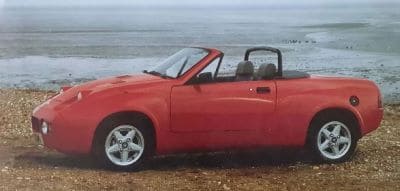 It's fair to say that each composite body kit needs a donor car for parts.
It's fair to say that each composite body kit needs a donor car for parts.
For the Midas models, the donor was usually a Mini Cooper or a Rover Metro.
Despite changing ownership several times since 1990, the Midas kit cars have "generally" been well received by enthusiasts.
The original versions had several options for engines, ranging between 1100cc and 1800cc wrapped inside the glass fibre monocoque shell.
Most of the mechanical assembly took place in Oldham, Greater Manchester in the early years. However, they moved the operation to Corby, Northamptonshire in 1981.
A factory fire destroyed the premises in March 1989 and all production ceased. Today, Alternative Cars Ltd continues the production in Clanfield, Oxfordshire with a choice between several kit form versions, such as the Gold Convertible, Cortez, and the Excelsior.
Napier
Napier is a British engineering company with a long and illustrious history. Besides the racing programme, they produced the first car to cross the Canadian Rockies - covering 3,536 miles from Boston to Vancouver in 1904.
By and large, they focused on luxury and high-performance cars, including the 1911 15hp Victoria and the "50 hp" car that won the Gordon Bennett Cup in 1902.
Noble
Noble Automotive Limited is a British manufacturer of the M12/400, M600 and another supercar soon to be released called the M500.
In the early years, Noble produced the two-door, two seater M10 1999 model - only available in convertible form. They powered it with a naturally aspirated (no turbo charger) 2.5-litre engine. Since then, the M12 is the car of choice being built as its replacement.
Panther Westwinds
Another first-class manufacturer of sports and high-end cars was Panther, based in the county of Surrey, in South East England.
The body of the 1972 retro-styled roadster, known as Panther Lima, was made from fibreglass. But, one of the top cars they produced was the Panther Rio in 1975.
They used most of the mechanical components from a small saloon car called the Triumph Dolomite for the 38 units that they built between 1975 and 1977.
Paramount Cars
It took three different locations for three different companies to produce most of the Paramount cars. Two of the locations were in Swadlincote and Melbourne (Derbyshire), and the third was at Leighton Buzzard (Bedfordshire).
Most of the Paramounts built between 1950 and 1956 had a wooden body frame covered with aluminium - and a tubular steel chassis.
They used Ford 10 components to reduce the cost of production and the 1172 cc side valve engine failed to impress the markets.
Peerless
Peerless may be the best British car company you've never heard of... until now. They started producing cars from their base in Slough, Berkshire in 1957. But, the company failed only three years later in 1960.
They built a four-seat sports car called the Peerless GT, using a space-frame chassis and a glass fibre body.
The engine and gearbox came from a similar car produced by the Standard Motor Company of Coventry, the Triumph TR3.
Peerless took part in the 24 Hours of Le Mans in 1958 and finished 16th. However, mass production ceased after reaching more than 320 units and the company closed in 1960.
Perry Motor Company
The company first started building the Perry car from their base in Tyseley, Birmingham. They released the first example in 1913 and the final unit came about in 1916.
Reliant Motor Company
Reliant Robin
It's not easy to find the right way to link sports cars that used to be everywhere to the Reliant Robin three-wheeled car. Nonetheless, we'll try.
The Reliant Motor Company started producing these small fibreglass cars in Tamworth, Staffordshire back in 1973. Three different versions were available during the period of its reign (e.g. the Mark 1, 2, and 3).
After the 2-door, two-seater Chevrolet Corvette, the Reliant Robin is the next most popular fibreglass car in history. In fact, at one time Reliant was the second-biggest British car manufacturer.
Check this out:
Even though it replaced the Reliant Regal in 1973, the first Robin ever built only had a 750 cc engine. But, the company upgraded it to the 850 cc version (offering 33 horsepower) two years later.
Do you know anyone who still has one? If so, they can confirm whether it actually does 0-60 mph in 16.2 seconds (in a straight line), and reach a top speed of 75 miles per hour, as claimed by the manufacturers.
Reliant Scimitar SS1
The Reliant Scimitar didn't reach the production line until 1964. Even so, a 22-year reign saw it transform from a coupe (GT model), to a sports estate (GTE), as well as the convertible variant (GTC) in 1978.
Rochdale
Rochdale Motor Panels and Engineering was a company based in Rochdale, Greater Manchester, England. The firm built glass fibre bodied sports cars from 1948 to 1973 and may be remembered most for the 1959 Olympic coupé.
Ronart Cars
Ronart has been producing lightweight sports cars since 1984. The company built the "licensed" Vanwall replicas several decades ago. Then, their focus switched to the W152 sports car and the Lightning V8.
Sheffield-Simplex
More than one hundred years ago you could have considered cars made by Sheffield-Simplex as being a credible rival to Rolls-Royce. But, you probably won't see them today because only three survived!
Squire
In the 1930s, the Squire Car Manufacturing Company built low-slung sports cars that had a supercharged, twin-overhead-camshaft 1.5-litre British Anzani engine.
Despite being extremely expensive, their cars were fast and well built. However, they only produced seven between 1935 and 1936 before Squire left the company and went to work for Aston Martin Lagonda.
Straker-Squire
From their base in Bristol, Straker had a good reputation for building steam engines. In 1906, they moved into the automotive industry and started producing the Straker-Squires.
Unipower
The Unipower GT made its debut back in 1966 and production finished in 1969. This British specialist mid-engined sports car uses the powertrain from the BMC Mini.
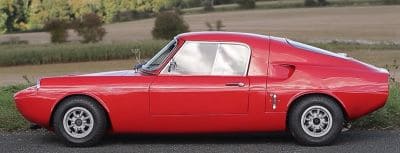 It's fair to call the Unipower a rare car. But, mounting the engine and gearbox nearer the back "amidships" - is not unique.
It's fair to call the Unipower a rare car. But, mounting the engine and gearbox nearer the back "amidships" - is not unique.
As a result, you would have to say that the Unipower GT was quiet when compared to other examples of a similar era.
Pro Tip: The factory stripped out all unnecessary trim and carpeting and produced seven specific GTs for competition (e.g. motorsports).
Vulcan Motor and Engineering Company
Even though Vulcan made cars at the large premises in Southport, England from 1902, they excelled at building commercial vehicles between 1914 and 1953.
After moving into a former drill hall, they expanded their range even further and started manufacturing various kinds of road sweepers and dustbin lorries.
Wilson-Pilcher
Built at their base in Newcastle upon Tyne, Wilson-Pilcher's first model had a 9 horsepower four cylinder flat engine with 2400 cc of displacement.
They replaced it with a 12/16 hp engine of 2694 cc capacity in 1903 and the range expanded in 1904 with a six-cylinder 18/24 HP engine of 4041 cc capacity.
Zenos Cars
Few people will have heard of Zenos Cars based in Wymondham, Norfolk. The British automotive company produces high-performance sports cars that are incredibly light.
There are three variants, the Zenos E10, E10 S, and E10 R. But, the company went into administration in January 2017 and a consortium purchased the assets.
You might also enjoy reading about...
There's a long list of awesome machines, including several classic SUVs and 4x4s, that we can't buy in the United Kingdom. This page spotlights some interesting and popular vehicles never sold in Great Britain and the key reasons why some are banned.